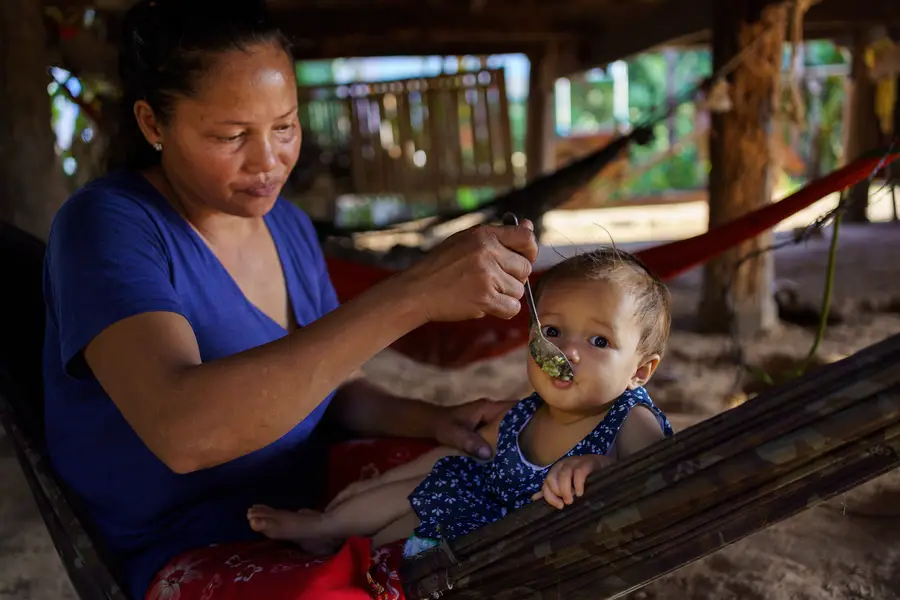Insights
How Will Climate Change Impact Global Nutrition?

Yea Chanteng feeds for her nine-month-old daughter, Mao Somavatey, in Bos Roka Village, Tbuong Khmum Province, Cambodia. Photo credit: Thomas Cristofoletti / Ruom for RTI International.
Rising carbon dioxide (CO2) emissions are a major driver of climate change. Projected changes in climate are expected to exacerbate the global disease burden by increasing existing health threats and contributing to the emergence of new ones in climate-vulnerable communities. Research is emerging on how climate change is directly impacting health through more frequent and extreme climate-driven weather hazards. Other studies are exploring changing patterns in the occurrence and severity of noncommunicable and vector-borne diseases, such as malaria, and the effect of climate change on global nutrition. Still, much remains to be done to more fully understand and mitigate these impacts.
In the case of global nutrition, climate change is expected to negatively impact global agricultural productivity, leading to reductions in food availability and price increases. Additionally, plants enhance their absorption of CO2 as it becomes more abundant in the atmosphere. This raises the concentration of carbohydrates in plant tissues while decreasing the concentrations of iron, zinc, calcium, potassium, and other nutrients essential to good health.
Implications of climate change on nutrition and public health
Some 2 billion people across the world, primarily women and children in the Global South, are currently deficient in iron and/or zinc. This has been linked to serious and chronic health problems, including stunting in children, impaired physical and cognitive development, anemia, depressed immune function, greater vulnerability to infection, undesirable outcomes in pregnancy, and neurobehavioral abnormalities. As climate change lowers agricultural productivity and higher CO2 levels reduce the concentration of essential micronutrients in food crops, we can expect to see both a worsening of existing deficiencies and greater numbers of malnourished people.
Micronutrient deficiency isn’t the only concern. Food crops with higher concentrations of carbohydrates and lower concentrations of essential nutrients can potentially contribute to the double burden of malnutrition, wherein countries are simultaneously experiencing overnutrition (too many carbohydrates and calories) and undernutrition (too few macro- and micronutrients). An increase in overnutrition could exacerbate obesity, which is already a leading cause of premature, preventable deaths. According to a World Bank report, obesity rates have tripled since 1975, accounting for about 4 million deaths annually worldwide. About 2 billion people are overweight. Some 70 percent of them reside in developing nations, which are predicted to see associated costs of $7 trillion over the next 12 years.
Additionally, plants grown at elevated CO2 may contain less protein, further exacerbating poor nutritional outcomes and jeopardizing the health of millions of people in developing nations who already consume insufficient protein. Any reduced protein content in plants could also have implications for the viability of plant-based diets and drive demand for high-protein animal products, which could further increase greenhouse gas emissions.
What we still don't know about climate change and nutrition
This critical issue is beginning to attract more attention in scientific and policy sectors. However, most of the research has been limited to major commodity crops, such as wheat, rice, corn, and soy. More studies are needed to assess the likely effects on fruits and vegetables, as well as on additional crops that account for a smaller share of global production but are important dietary components in certain regions (e.g., millet, teff). Such crops, which are well-suited to production in specific regions, could become increasingly important in regionalized adaptations to climate change impacts.
We also need to look at how this phenomenon will affect the quality of pasture grass and livestock forage. This is important because livestock are a key source of food and income in developing nations. Additionally, protein consumption is predicted to increase worldwide as population and incomes grow, placing greater demands on the livestock sector. More research is needed to answer key questions. For example, there is some evidence that forage productivity is impacted less negatively, or may even experience yield gains, relative to most feed crops under climate change scenarios projected for mid-century. But if pasture grass and forage is predicted to have a lower nutritional profile under climate change, how will that affect feeding practices? What adjustments will be necessary to ensure that livestock are raised productively and cost-effectively with changes in relative yields and nutrition profiles of different sources of feed and forage? To what extent will prices of animal-based products be impacted?
It’s likely that the answers to such questions will differ according to location, farming practices, and the type of crops and livestock being raised. Although overall global impacts on agriculture are generally expected to be negative, modeling shows tremendous variability in how climate change will play out around the world, with various regions likely to experience greater or lesser productivity. Other factors also complicate assessments, such as the fertilization effect achieved through elevated CO2 and the isolated and cumulative impacts of increasingly frequent extreme weather events.
A holistic approach to nutrition and climate action
While there are uncertainties that must be accounted for when developing climate change adaptation strategies, it’s important that we begin putting tangible actions in place while continuously improving our strategies as we keep learning. The extremely high temperatures recorded this past summer in many regions of the world offered a grim glimpse of what lies ahead. As we gather additional information, we can refine possible solutions to these anticipated nutritional shortfalls and prepare for impacts on the health care system.
Though it takes time to bring a new variety or breed to market, advances in plant and animal breeding offer some hope. Drought- and salinity-tolerant crops and heat-tolerant breeds of cattle also could help ensure food production in challenging conditions. New advances in agriculture are most effective when they are accompanied by greater outreach and education to ensure uptake by farmers, so funding sources for that effort should be identified. Similarly, we must work with farmers to adopt better practices, such as reducing erosion and improving soil, that support sustainable intensification and offer the potential of higher yields, which in turn build rural incomes and climate resilience.
Other options include increasing nutrients through food fortification and biofortification, though that likely would not fully address the problem, particularly in regions where people are already experiencing dietary deficiencies. Greater efforts could be made to reinforce the intersections between agriculture and health to effectively integrate nutrition interventions (e.g. supplements) into public health programs. Another option is loosening trade agreements to allow imports of crops that have been nutritionally fortified or otherwise enhanced.
Reduced agricultural productivity and declining nutritional value of plants are just two pieces of the climate change puzzle. It is important that we take a holistic approach as we seek to develop effective mitigation and adaptation strategies. The goals of improved food security and better nutrition and health must guide our plans and efforts. The lives of billions and the well-being of future generations hang in the balance.
Learn more about RTI's work in global food security, agriculture, and nutrition and RTI's Center for Climate Solutions.
Disclaimer: This piece was written by Robert H. Beach (RTI Fellow, Agricultural, Resource & Energy Economics and Policy Program) and Tracy Mitchell (Director, Agriculture) to share perspectives on a topic of interest. Expression of opinions within are those of the author or authors.


